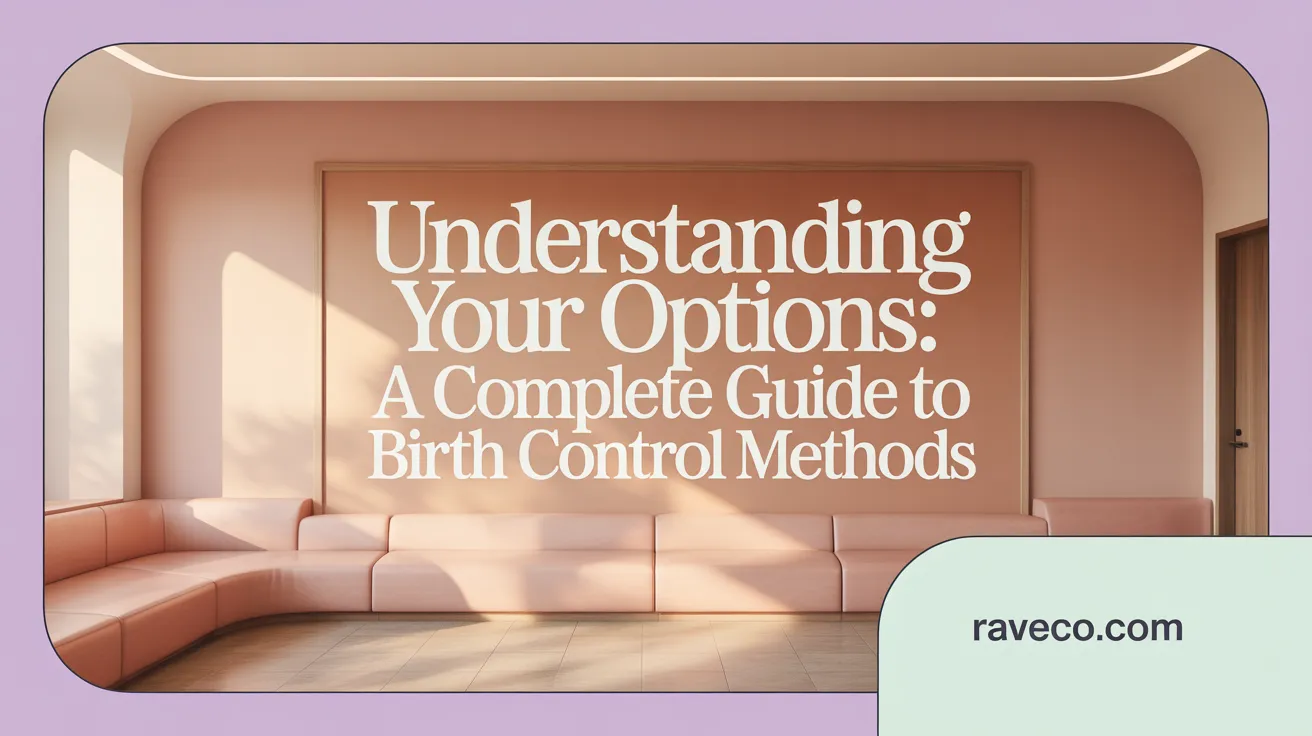Transforming Lives: Real Experiences of Women After Fibroid Treatment

Understanding Your Options for Birth Control
Choosing the right birth control method is a highly personal decision influenced by individual health, lifestyle, reproductive goals, and preferences. This guide explores various contraception options, their effectiveness, benefits, and considerations to help you make informed choices that fit your lifestyle.
Types of Birth Control: An Overview

What types of birth control methods are available?
Birth control encompasses a variety of methods designed to prevent pregnancy through different mechanisms. These methods fall mainly into hormonal and non-hormonal categories, with further distinctions based on reversibility. For detailed guidance on choosing the right birth control, see reliable resources.
Categories of birth control methods
- Hormonal methods: Include pills, patches, vaginal rings, injections, implants, and hormonal IUDs. These primarily work by preventing ovulation, thickening cervical mucus to block sperm, and thinning the uterine lining to prevent implantation.
- Non-hormonal methods: Include copper IUDs and barrier methods like condoms, diaphragms, cervical caps, sponges, and spermicides. These methods usually work by physically blocking sperm from reaching the egg or creating an inhospitable environment for fertilization.
- Fertility awareness-based methods: Involve tracking fertility signs such as menstrual cycles, cervical mucus, and basal body temperature to avoid intercourse on fertile days; see fertility awareness-based birth control.
- Emergency contraception: Pills and copper IUDs used after unprotected sex to prevent pregnancy, effective within a specific time frame; learn about emergency contraception options.
- Permanent methods: Surgical options like tubal ligation in women and vasectomy in men, intended for irreversible contraception; details on permanent sterilization methods.
Hormonal versus non-hormonal options
Hormonal methods utilize synthetic hormones (estrogen and/or progestin) to inhibit ovulation and alter reproductive tract conditions. Non-hormonal options do not contain hormones; for example, copper IUDs release copper to impair sperm function. Barrier methods physically prevent sperm entry and provide the added benefit of STI protection, especially condoms (see Barrier methods and STI prevention).
Permanent versus reversible
Most birth control methods are reversible, allowing for the return of fertility after discontinuation, such as IUDs and pills. Permanent methods like tubal ligation and vasectomy are surgical and intended for lifelong contraception with very low failure rates; refer to permanent sterilization methods.
Examples by category
| Category | Examples | Description |
|---|---|---|
| Hormonal (reversible) | Pills, patch, ring, injections, implants, hormonal IUDs | Prevent ovulation, change cervical mucus, thin uterine lining |
| Non-hormonal (reversible) | Copper IUD, condoms, diaphragms, cervical caps, sponges, spermicides | Physical barrier or sperm-toxic environment |
| Fertility awareness | Calendar method, cervical mucus, basal body temperature tracking | Cycle-based avoidance of intercourse on fertile days |
| Emergency contraception | Copper IUD, levonorgestrel pills, ulipristal acetate pills | Used after unprotected sex to prevent pregnancy |
| Permanent | Tubal ligation, vasectomy | Surgical procedures for permanent contraception |
Choosing the appropriate method depends on factors like personal health, convenience, desire for future pregnancy, and the need for STI protection. Consulting healthcare providers is crucial to make an informed choice tailored to individual needs.
Effectiveness and Reliability of Birth Control Methods
How effective are different birth control methods at preventing pregnancy?
Birth control methods vary widely in their effectiveness at preventing pregnancy, influenced by how they are used and their design. For more information, see Choosing the right birth control.
Pregnancy prevention rates
Long-acting reversible contraceptives (LARCs), such as intrauterine devices (IUDs) and implants, are among the most effective methods. They have failure rates under 1%, meaning fewer than one pregnancy per 100 users annually. These devices provide long-term protection ranging from 3 to 10 years depending on the type. Learn more about Long-acting reversible contraceptives and IUDs for birth control.
Hormonal methods including birth control pills, patches, and vaginal rings have typical use effectiveness rates around 91-93%, with perfect use increasing this to near 99%. Effectiveness can decrease if doses are missed or used incorrectly. Details on Hormonal birth control methods and Birth control pill effectiveness provide further understanding.
Typical versus perfect use effectiveness
Typical use accounts for human error and inconsistent application, while perfect use means following all instructions precisely. For example, male condoms have about 85% effectiveness with typical use but up to 98% with perfect use. See How well does it work? and Effectiveness of birth control methods.
Barrier methods effectiveness
Barrier methods such as male condoms provide dual benefits: pregnancy prevention and protection against sexually transmitted infections (STIs). With typical use, male condoms are about 85% effective at preventing pregnancy. Female condoms tend to have slightly lower effectiveness. More on Barrier methods and STI prevention and Condom effectiveness.
Permanent methods
Permanent solutions like tubal ligation and vasectomy are more than 99% effective, intended for individuals who are certain they do not want future pregnancies. These surgical methods require no ongoing user action. Explore Permanent sterilization methods and Sterilization procedures.
Emergency contraception effectiveness
Emergency contraception is effective if used very soon after unprotected sex. Pills like levonorgestrel are most effective when taken within 72 hours, with up to 90% effectiveness. Copper IUDs, when inserted within five days, are nearly 100% effective as emergency contraception and provide ongoing pregnancy prevention. See Emergency contraception options and Emergency contraception details.
Understanding the effectiveness of various birth control methods helps in making informed choices best suited to individual needs, lifestyle, and health conditions. Consultation with healthcare providers ensures proper use and personalized recommendations.
Considering Sexual Health and STI Protection

Which birth control methods protect against sexually transmitted infections (STIs)?
Condoms, both male and female, stand out as the only birth control methods that effectively protect against sexually transmitted infections (STIs), including HIV. While other birth control options like hormonal pills, intrauterine devices (IUDs), and implants are highly effective at preventing pregnancy, they do not offer any protection against STIs.
Role of condoms
Condoms act as a physical barrier that prevents the exchange of bodily fluids during sexual activity, significantly reducing the risk of transmission of infections such as HIV, chlamydia, and gonorrhea. Their dual role in pregnancy prevention and STI protection makes them a vital element of sexual health.
Importance of dual protection
Since many highly effective contraceptive methods do not shield against STIs, combining condoms with another form of birth control is recommended. This dual protection approach ensures prevention of both unintended pregnancy and sexually transmitted infections.
STI testing recommendations
Regular testing for STIs and HIV is crucial, especially because many infections may not show symptoms. Engaging in routine screenings helps in early detection and treatment, promoting overall sexual health and wellbeing.
Using condoms consistently and correctly, alongside other contraceptive methods, and maintaining regular STI testing supports comprehensive sexual health protection.
Matching Birth Control to Your Lifestyle and Preferences

What factors should influence my choice of birth control method?
Choosing the right birth control depends on several lifestyle and health factors to best fit your needs and preferences.
Frequency of sexual activity
If you have sex frequently, long-acting reversible contraceptives (LARCs) like IUDs or implants may be ideal as they provide continuous protection without daily attention. For occasional sex, barrier methods such as condoms or fertility awareness might be more convenient.
Need for STI protection
Condoms are the only birth control method that effectively protects against sexually transmitted infections (STIs). If STI prevention is important, using condoms—alone or alongside another method—is recommended.
Convenience and usage schedules
Daily methods like the birth control pill require strict adherence, which may be less ideal for some. Patches and vaginal rings require weekly or monthly changes, while injections are quarterly. LARCs offer long-term, low-maintenance protection, suitable for those who prefer less frequent dosing.
Health conditions affecting choice
Health issues such as migraines with aura, high blood pressure, smoking (especially over age 35), or history of blood clots may mean estrogen-containing methods (combination pills, patch, ring) are inadvisable. Progestin-only options or non-hormonal methods like copper IUDs may be safer.
Future pregnancy plans
If you wish to delay but potentially have children later, reversible methods like IUDs, implants, pills, or barrier methods are appropriate. Permanent solutions like tubal ligation or vasectomy are for those certain they do not want future pregnancies.
Careful consideration and consultation with healthcare providers help match your birth control to your lifestyle, health, and reproductive goals for safe and effective contraception.
Health Considerations and Safety of Birth Control Methods
Are there health risks or considerations when choosing birth control?
Certain health conditions significantly influence the safety of birth control choices. Women with uncontrolled high blood pressure, a history of blood clots, breast cancer, migraine with aura, or those who smoke over the age of 35 face increased risks if using estrogen-containing contraceptives like combined oral pills. These risks include blood clots, heart attack, and stroke. For more information, see Health Considerations for Hormonal Methods, Risks of hormonal contraception, and Blood clot risks and birth control.
Contraindications for hormonal contraceptives
Because of these risks, many healthcare providers discourage or avoid prescribing combined hormonal contraceptives for women with these conditions. Instead, progestin-only contraceptives, such as the progestin-only pill, implant, or hormonal IUDs, are often preferred as they generally carry fewer cardiovascular and clotting risks. See details on Progestin-only birth control pills and Hormonal contraceptive methods.
Side effects of hormonal and non-hormonal methods
Hormonal methods commonly cause side effects including irregular bleeding, nausea, headaches, and breast tenderness, especially during initial months of use. These symptoms generally diminish with continued use. The birth control injection may lead to additional side effects like weight gain and can delay return to fertility by several months after discontinuation. For comprehensive side effects information, refer to Birth control side effects, Adverse effects of hormonal contraceptives, and Birth control shot details.
Non-hormonal options, such as the copper IUD, avoid hormonal side effects but may cause menstrual changes, including heavier or longer periods and increased cramping. Learn more from Copper IUD benefits and side effects, and Natural birth control options.
Managing adverse effects
Adverse effects are typically mild and often resolve after a few months. Persistent or severe symptoms warrant consultation with a healthcare provider who may suggest switching methods or provide strategies for relief. Guidance on consulting providers is available at Consultation with healthcare providers and Personalized birth control advice.
Pregnancy and breastfeeding considerations
For breastfeeding women or those wishing to conceive soon, progestin-only pills or devices are safer choices. Combined hormonal methods are generally avoided during breastfeeding due to potential estrogen effects on milk supply and infant health. See Birth control and breastfeeding and Contraceptive choice for breastfeeding women.
Consulting healthcare professionals for personalized evaluation ensures safe, effective birth control tailored to individual health profiles and life plans. For selecting methods aligned to your lifestyle, visit Guide to choosing birth control and Choosing the right birth control.
Long-Acting Reversible Contraceptives (LARCs): Benefits and Usage
What are long-acting reversible contraceptives and are they suitable for me?
Long-acting reversible contraceptives (LARCs) are highly effective birth control methods that provide long-term pregnancy prevention with minimal effort required after insertion. The main types include hormonal intrauterine devices (IUDs) like Mirena and Skyla, copper IUDs such as ParaGard, and contraceptive implants like Nexplanon.
Types of LARCs
- Hormonal IUDs: These small, T-shaped devices release progestin and typically last between 3 to 8 years. They can reduce menstrual bleeding and cramps (Learn more).
- Copper IUDs: Non-hormonal devices effective for up to 10 years. They may increase menstrual bleeding and cramps but provide hormone-free contraception (More info).
- Implants: Tiny rods inserted under the skin of the upper arm releasing progestin, effective for up to 3 years (Details here).
Duration and Effectiveness
LARCs offer over 99% effectiveness in preventing pregnancy, significantly reducing user error compared to methods requiring daily attention (Source).
Insertion and Removal Processes
LARCs must be inserted and removed by healthcare professionals. The procedures are usually quick and can be done in outpatient settings. Fertility returns almost immediately upon removal, allowing users to plan pregnancies when ready (See details).
Impact on Menstrual Cycles
Hormonal IUDs often result in lighter periods or may stop menstruation entirely, offering relief from heavy bleeding. Conversely, copper IUDs may cause heavier or longer menstrual flows, particularly in the initial months (Learn more).
Suitability for Different Users
LARCs are ideal for individuals seeking reliable, long-term contraception with low maintenance. They are suitable for women of all reproductive ages, including those who have never had children. Users looking to avoid daily medication or frequent visits benefit greatly from LARCs (More info).
Return of Fertility
Fertility typically returns rapidly after LARC removal, except for the contraceptive injection, which may delay fertility for several months in some cases. Hormonal IUDs and implants allow pregnancy chances to resume almost immediately (Details).
Long-acting reversible contraceptives combine convenience, effectiveness, and flexibility, making them a preferred choice for many individuals seeking dependable birth control solutions (Explore options).
Hormonal Birth Control: Pills, Patch, Ring, and Shots

What are the options and considerations for hormonal birth control methods?
Hormonal birth control options include several forms: combined oral contraceptive pills (which contain both estrogen and progestin), progestin-only pills (also called minipills), the contraceptive patch, vaginal rings, and injectable contraceptives like the Depo-Provera shot.
Pills: Taken daily, combined pills work by preventing ovulation, thickening cervical mucus to block sperm, and thinning the uterine lining to prevent implantation. Progestin-only pills mainly thicken cervical mucus and may suppress ovulation.
Patch: A hormone patch applied to the skin once weekly releases estrogen and progestin.
Vaginal Ring: Inserted into the vagina for three weeks at a time and then removed for a week, releasing hormones locally.
Shot: The Depo-Provera injection delivers progestin every three months to prevent ovulation.
The effectiveness of these methods ranges from about 91% with typical use to nearly 99% with perfect use. Choosing the right method requires consideration of lifestyle, ability to adhere to the regimen, and health conditions.
Benefits and side effects
Hormonal contraceptives offer benefits beyond pregnancy prevention. These include regulation of menstrual cycles, lighter and less painful periods, reduction of premenstrual syndrome symptoms, and improvements in acne and certain reproductive health conditions.
Common side effects can include breakthrough bleeding, nausea, headaches, breast tenderness, and mood changes. Some women, especially those with risk factors like smoking over age 35 or a history of blood clots, may face increased risks such as blood clots or cardiovascular issues.
Medical consultation is essential to screen for contraindications and select a method that balances effectiveness with safety and personal comfort.
Barrier and Fertility Awareness Methods
How do barrier methods and fertility awareness work, and how effective are they?
Barrier methods work by physically blocking sperm from reaching the egg. Common barrier methods include male condoms, female condoms, diaphragms, cervical caps, and contraceptive sponges, often used with spermicide to increase effectiveness (Barrier methods and STI prevention, Barrier methods of birth control.
- Male condoms have about 85% effectiveness with typical use and are the only barrier method that also offers substantial protection against sexually transmitted infections (STIs) (Effectiveness of male condoms, Condom effectiveness rates).
- Female condoms are about 79% effective with typical use and also provide some STI protection (Female condoms and diaphragms.
- Diaphragms are about 83%-87% effective when used correctly along with spermicide (Diaphragms and cervical caps, Diaphragms with spermicide usage.
- Cervical caps offer roughly 71% to 85% effectiveness depending on usage and whether spermicide is used (Cervical caps effectiveness.
- Contraceptive sponges range between 78% to 86% effectiveness, especially effective in women who have not given birth (Sponge birth control effectiveness.
- Spermicide alone is about 70% effective, but the addition of spermicide with barrier methods improves pregnancy prevention, reaching up to 94% effectiveness (Spermicide effectiveness.
Fertility awareness-based methods involve tracking fertility signals such as basal body temperature, cervical mucus changes, and menstrual cycle patterns to avoid intercourse on fertile days. These methods have a lower reliability rate, with typical effectiveness between 75% and 88% (Fertility awareness-based birth control, Fertility awareness methods explained. They require meticulous monitoring, consistency, and understanding of one's cycle.
However, fertility awareness methods do not offer any protection against STIs, making them unsuitable for STI prevention. Barrier methods like male condoms remain the best dual-purpose choice for both pregnancy prevention and STI protection (Condoms and STI protection, Using condoms for HIV and STI prevention.
Choosing barrier or fertility awareness methods may appeal to those who prefer hormone-free options or need contraception compatible with breastfeeding or specific health considerations, though understanding their limitations is crucial for effective use (Choosing the right birth control, Hormone-free birth control).
Emergency and Permanent Birth Control Solutions

What are emergency and permanent birth control options?
Emergency contraception provides a critical option to prevent pregnancy after unprotected sex or contraceptive failure. One highly effective method is the copper intrauterine device (IUD), which can be inserted within five days (120 hours) after intercourse and offers nearly 100% effectiveness. Additionally, emergency contraceptive pills such as levonorgestrel (Plan B) and ulipristal acetate (Ella) are most effective when taken as soon as possible, ideally within 72 hours but can be used up to five days.
Permanent birth control consists of surgical procedures designed for individuals confident they do not want future pregnancies. For women, tubal ligation or salpingectomy are common sterilization surgeries that block or remove the fallopian tubes, preventing fertilization. For men, vasectomy is a simple, outpatient procedure that cuts or seals the vas deferens to prevent sperm delivery. Both methods boast effectiveness rates exceeding 99% and are considered irreversible, making thorough consultation with healthcare providers essential beforehand.
When should these methods be considered?
Emergency contraception is suitable immediately following unprotected intercourse or contraceptive failure and is not intended for routine use. Permanent sterilization is appropriate for those certain they have completed childbearing, desire long-term contraception, or face health risks with pregnancy. Since sterilization is irreversible, thorough counseling to explore all contraceptive options, health history, and future reproductive goals is critical.
Access and consultation
Access to emergency contraception varies: copper IUD insertion requires a trained healthcare provider and often a clinic visit, while emergency pills are sometimes available over-the-counter. Permanent sterilization requires surgical consultation, evaluation, and informed consent. Insurance often covers these methods, and healthcare providers can guide individuals in selecting the method best suited to their needs and circumstances while ensuring safety and informed choice.
Making Informed Choices for Your Reproductive Health
Choosing the right birth control method is a balance of understanding effectiveness, health considerations, lifestyle needs, and future reproductive goals. With a wide variety of options available, consulting healthcare providers helps ensure a choice that supports both your sexual health and personal lifestyle. Open communication, awareness of side effects, and regular health check-ups empower you to maintain control over your reproductive well-being.





.png)